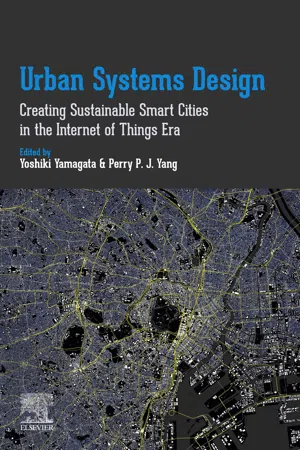
Urban Systems Design
Creating Sustainable Smart Cities in the Internet of Things Era
- 460 pages
- English
- ePUB (mobile friendly)
- Available on iOS & Android
Urban Systems Design
Creating Sustainable Smart Cities in the Internet of Things Era
About this book
Urban Systems Design: Creating Sustainable Smart Cities in the Internet of Things Era shows how to design, model and monitor smart communities using a distinctive IoT-based urban systems approach. Focusing on the essential dimensions that constitute smart communities energy, transport, urban form, and human comfort, this helpful guide explores how IoT-based sharing platforms can achieve greater community health and well-being based on relationship building, trust, and resilience. Uncovering the achievements of the most recent research on the potential of IoT and big data, this book shows how to identify, structure, measure and monitor multi-dimensional urban sustainability standards and progress.This thorough book demonstrates how to select a project, which technologies are most cost-effective, and their cost-benefit considerations. The book also illustrates the financial, institutional, policy and technological needs for the successful transition to smart cities, and concludes by discussing both the conventional and innovative regulatory instruments needed for a fast and smooth transition to smart, sustainable communities.- Provides operational case studies and best practices from cities throughout Europe, North America, Latin America, Asia, Australia, and Africa, providing instructive examples of the social, environmental, and economic aspects of "smartification- Reviews assessment and urban sustainability certification systems such as LEED, BREEAM, and CASBEE, examining how each addresses smart technologies criteria- Examines existing technologies for efficient energy management, including HEMS, BEMS, energy harvesting, electric vehicles, smart grids, and more
Frequently asked questions
- Essential is ideal for learners and professionals who enjoy exploring a wide range of subjects. Access the Essential Library with 800,000+ trusted titles and best-sellers across business, personal growth, and the humanities. Includes unlimited reading time and Standard Read Aloud voice.
- Complete: Perfect for advanced learners and researchers needing full, unrestricted access. Unlock 1.4M+ books across hundreds of subjects, including academic and specialized titles. The Complete Plan also includes advanced features like Premium Read Aloud and Research Assistant.
Please note we cannot support devices running on iOS 13 and Android 7 or earlier. Learn more about using the app.
Information
Urban systems design
shaping smart cities by integrating urban design and systems science
Abstract
Keywords
1.1. Cities as flows: emerging new urban forms driven by smart city movement
1.1.1. Theories for smart cities


1.1.2. Cities as flows: an emerging new urban form
Table of contents
- Cover image
- Title page
- Table of Contents
- Copyright
- Contributors
- Preface
- Chapter 1. Urban systems design: shaping smart cities by integrating urban design and systems science
- Chapter 2. Urban systems and the role of big data
- Chapter 3. Modeling and design of smart buildings
- Chapter 4. Smart buildings of urban communities
- Chapter 5. Integrating mobility in urban design
- Chapter 6. Modeling and design of smart mobility systems
- Chapter 7. Spatial modeling and design of smart communities
- Chapter 8. Case studies toward smart communities
- Chapter 9. Smart city and ICT infrastructure with vehicle to X applications toward urban decarbonization
- Chapter 10. IoT-based monitoring for smart community
- Chapter 11. Urban sustainability assessment tools: toward integrating smart city indicators
- Chapter 12. Measuring quality of walkable urban environment through experiential modeling
- Chapter 13. Understanding the potentials of green bonds and green certification schemes for the development of future smart cities
- Chapter 14. Institutional instruments for urban systems design—from the planner's perspective
- Index